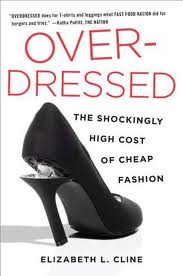The Price of Fashion
Author: Elizabeth L. Cline
 Like many of us, author Elizabeth Cline used to buy cheap new items of clothing from discount chains almost every week — even though the shoddy garments quickly fell apart, faded, or never really fit right to begin with. At $5 for a T-shirt, she thought, what did it matter? Then she started wondering about the environmental, social, and economic effects of our compulsive bargain-basement consumption. When did we collectively decide that our desire for cheap, trendy clothing outweighed fair labor practices, intellectual property rights, and our planet’s health? If you don’t think you’re voting with your consumer dollars, think again: we’ve brought this wasteful, gluttonous state of affairs on ourselves.
Like many of us, author Elizabeth Cline used to buy cheap new items of clothing from discount chains almost every week — even though the shoddy garments quickly fell apart, faded, or never really fit right to begin with. At $5 for a T-shirt, she thought, what did it matter? Then she started wondering about the environmental, social, and economic effects of our compulsive bargain-basement consumption. When did we collectively decide that our desire for cheap, trendy clothing outweighed fair labor practices, intellectual property rights, and our planet’s health? If you don’t think you’re voting with your consumer dollars, think again: we’ve brought this wasteful, gluttonous state of affairs on ourselves.
Cline begins with a bit of fashion history, comparing the typical household clothing budget in the early 20th century to ours today. Americans now buy about 68 garments and 7 pairs of shoes per year, but it wasn’t always this way: in the past, people had maybe a week’s worth of outfits total, which they carefully maintained, mended, and accessorized to get as much wear as possible. Old or outgrown garments would be handed down, taken apart and resewn into new items, and finally relegated to cleaning rags or quilt scraps; nothing was thrown away until it literally fell apart. Yet unlike most other staples, such as food or housing, the cost of domestically produced clothing has pretty much stayed proportionally the same; it’s just that we’re now unwilling to pay the price for better-quality materials, skilled tailoring, and livable wages for garment sewers.
Next, the author explores the rise of the massive international budget-clothing chains and how their lightning-fast production process and rock-bottom prices (made possible by cheap overseas factory labor) harmed independent designers who struggle to sell higher-quality clothes at a fair cost. Surprisingly, clothing patterns aren’t considered intellectual property, which is how all those knockoffs thrive — and they work so fast that runway copies can be in stores in as little as two weeks.
Daringly, Cline even poses as the owner of a (nonexistent) fashion design company, taking some of her own garments as “samples” to factories in China and Bangladesh in order to tour the factories and get a close-up look at where our clothes are made. Even within Asian clothing factories, there’s a quality hierarchy; Chinese factories are considered more high-tech and their workers more skilled, which is why you’ll often see cheap basics such as T-shirts from emerging countries like Bangladesh or Vietnam, and more complicated, embellished garments from China.
Most intriguingly for me, she also follows the trail of our well-meaning — but overwhelming and largely unhelpful — clothing donations to thrift stores. Donating unwanted clothing relieves some of the guilt of wasting money on poor-quality “bargains” that we don’t expect to last, and gives us the warm, fuzzy feeling that our pilled, shrunken polyester tops will make some poor person’s eyes light up with joy. The reality is much less heartwarming. It’s a bit nausea-inducing to read about the mountains of unwanted garments that get donated to charity stores daily. Faced with far more product than they could ever sell, thrift stores sell giant bales of clothes to rag merchants to tear apart for secondary uses (like stuffing car seats), or to African resellers who buy in bulk. If no other use can be found, they may ultimately end up in a landfill. And all too often, it’s brand-new, unwanted brand-name clothing in those piles of cast-offs.
I know, this is sounding pretty bad! But Cline is not out to destroy your fun — she just wants to help you make better choices. Her suggestions on how we can break the cycle with our own purchasing habits include buying second-hand or vintage items when possible; rewarding quality and innovation by purchasing new items from manufacturers who design well and pay workers a livable wage; organizing community clothing swaps with friends; and choosing to maintain and repair items to extend their useful life. Oh, and I suppose you could always get crafty and make your own, best of all! If you’re a fashion enthusiast, interested in environmental issues, or just harbor a seething hatred of corporate clothing chains, Overdressed will get you thinking about the contents of your closet.
— Stephanie P.
- Spring 2020 Book Preview - May 15, 2020
- Winter 2020 Book Preview - January 1, 2020
- Fall 2019 Book Preview - September 26, 2019


Leave A Comment